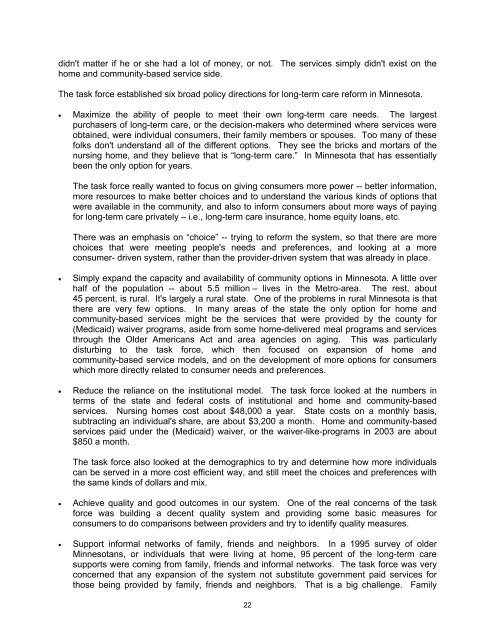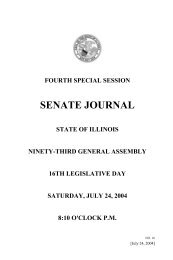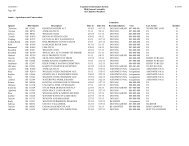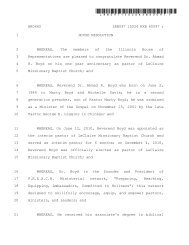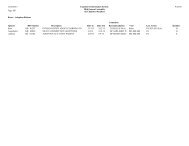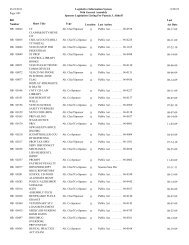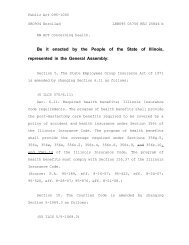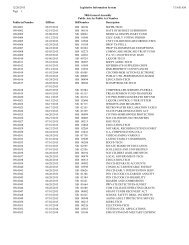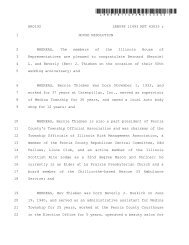Long-Term Care - Illinois General Assembly
Long-Term Care - Illinois General Assembly
Long-Term Care - Illinois General Assembly
Create successful ePaper yourself
Turn your PDF publications into a flip-book with our unique Google optimized e-Paper software.
didn't matter if he or she had a lot of money, or not. The services simply didn't exist on the<br />
home and community-based service side.<br />
The task force established six broad policy directions for long-term care reform in Minnesota.<br />
• Maximize the ability of people to meet their own long-term care needs. The largest<br />
purchasers of long-term care, or the decision-makers who determined where services were<br />
obtained, were individual consumers, their family members or spouses. Too many of these<br />
folks don't understand all of the different options. They see the bricks and mortars of the<br />
nursing home, and they believe that is “long-term care.” In Minnesota that has essentially<br />
been the only option for years.<br />
The task force really wanted to focus on giving consumers more power -- better information,<br />
more resources to make better choices and to understand the various kinds of options that<br />
were available in the community, and also to inform consumers about more ways of paying<br />
for long-term care privately – i.e., long-term care insurance, home equity loans, etc.<br />
There was an emphasis on “choice” -- trying to reform the system, so that there are more<br />
choices that were meeting people's needs and preferences, and looking at a more<br />
consumer- driven system, rather than the provider-driven system that was already in place.<br />
• Simply expand the capacity and availability of community options in Minnesota. A little over<br />
half of the population -- about 5.5 million – lives in the Metro-area. The rest, about<br />
45 percent, is rural. It's largely a rural state. One of the problems in rural Minnesota is that<br />
there are very few options. In many areas of the state the only option for home and<br />
community-based services might be the services that were provided by the county for<br />
(Medicaid) waiver programs, aside from some home-delivered meal programs and services<br />
through the Older Americans Act and area agencies on aging. This was particularly<br />
disturbing to the task force, which then focused on expansion of home and<br />
community-based service models, and on the development of more options for consumers<br />
which more directly related to consumer needs and preferences.<br />
• Reduce the reliance on the institutional model. The task force looked at the numbers in<br />
terms of the state and federal costs of institutional and home and community-based<br />
services. Nursing homes cost about $48,000 a year. State costs on a monthly basis,<br />
subtracting an individual's share, are about $3,200 a month. Home and community-based<br />
services paid under the (Medicaid) waiver, or the waiver-like-programs in 2003 are about<br />
$850 a month.<br />
The task force also looked at the demographics to try and determine how more individuals<br />
can be served in a more cost efficient way, and still meet the choices and preferences with<br />
the same kinds of dollars and mix.<br />
• Achieve quality and good outcomes in our system. One of the real concerns of the task<br />
force was building a decent quality system and providing some basic measures for<br />
consumers to do comparisons between providers and try to identify quality measures.<br />
• Support informal networks of family, friends and neighbors. In a 1995 survey of older<br />
Minnesotans, or individuals that were living at home, 95 percent of the long-term care<br />
supports were coming from family, friends and informal networks. The task force was very<br />
concerned that any expansion of the system not substitute government paid services for<br />
those being provided by family, friends and neighbors. That is a big challenge. Family<br />
22


